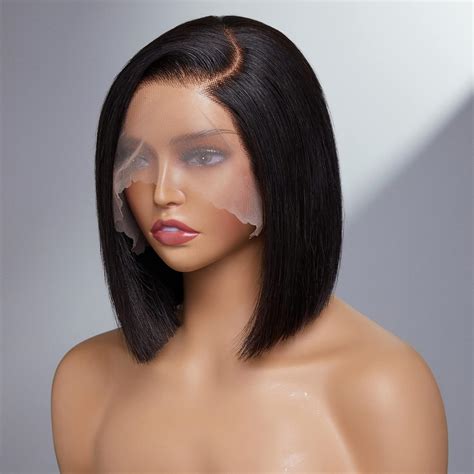Introduction
Wigs and hair pieces have become increasingly popular in recent years, offering a wide range of benefits from hair loss solutions to style transformations. Understanding the different types, materials, and applications of wigs and hair pieces is crucial to finding the best option for your needs.

Types of Wigs & Hair Pieces
Wigs:
- Full Wigs: Cover the entire head, providing complete hair coverage.
- Lace Front Wigs: Feature a lace front that creates a realistic hairline.
- Mono Top Wigs: Have a monofilament top that allows for natural hair movement.
- Synthetic Wigs: Made from artificial fibers, offering affordability and low maintenance.
- Human Hair Wigs: Made from real human hair, providing the most natural look and feel.
Hair Pieces:
- Clip-In Hair Extensions: Allow for temporary hair volume and length.
- Halo Hair Extensions: Attach around the head, creating a natural blend.
- Toppers: Cover the top of the head to conceal thinning hair.
- Bangs and Fringes: Can be added to wigs or natural hair for style versatility.
Materials
Synthetic Fibers:
- Kanekalon: Known for its silky texture and resistance to heat.
- Toyokalon: Offers a soft, natural-like feel.
- Modacrylic: Fire-retardant and resistant to damage.
Human Hair:
- European Hair: Considered the finest quality, with a soft texture and easy styling.
- Indian Hair: Thicker and coarser than European hair, but still versatile for styling.
- Chinese Hair: Durable and affordable, but requires more care due to its lower cuticle count.
Applications
Hair Loss Solutions:
- Alopecia: Loss of hair due to autoimmune disorders or medical treatments.
- Thinning Hair: Gradual loss of hair from aging, genetics, or stress.
- Chemotherapy: Hair loss as a side effect of cancer treatments.
Style Transformations:
- Length and Volume: Enhance natural hair with clip-in extensions or full wigs.
- Color and Texture: Experiment with different hair styles and textures without damaging your own hair.
- Cosplay and Halloween: Create realistic costumes and complete character transformations.
Market Trends
According to the American Hair Loss Association:
- Over 50 million Americans suffer from some form of hair loss.
- The global wig and hair extensions market is projected to reach $17.8 billion by 2025.
- Human hair wigs are growing in popularity due to their natural appearance and versatility.
Choosing the Right Wig or Hair Piece
Consider Your Needs: Identify the purpose of the wig or hair piece, whether it’s for hair loss, style enhancement, or cosplay.
Determine Your Hair Type: Match the texture and color of the wig or hair piece to your natural hair to ensure a seamless transition.
Choose a Comfortable Material: Synthetic fibers offer affordability and durability, while human hair provides a more natural look and feel.
Care and Maintenance
Synthetic Wigs:
- Wash with cool water and mild shampoo.
- Avoid using heat styling tools.
- Store in a dry place away from direct sunlight.
Human Hair Wigs:
- Wash with lukewarm water and sulfate-free shampoo.
- Use heat protectant spray before using styling tools.
- Store in a cool, dry place with a wig stand.
Hair Pieces:
- Clip-in extensions can be washed with your natural hair.
- Halo extensions should be brushed regularly and washed occasionally.
- Toppers and bangs can be washed with cool water and mild shampoo.
Creative Applications of Wigs & Hair Pieces
Medical Prosthesis: Wigs and hair pieces can provide a discreet solution for patients with severe hair loss due to medical conditions.
Special Effects: Wigs and hair pieces are essential for creating realistic costumes and characters in film, television, and theater.
Gender Expression: Wigs and hair pieces empower individuals to express their gender identity and explore different hairstyles without permanent modifications.
Tables for Reference
Table 1: Types of Wigs
| Type | Description |
|---|---|
| Full Wig | Covers the entire head |
| Lace Front Wig | Lace front creates a realistic hairline |
| Mono Top Wig | Monofilament top allows for natural hair movement |
| Synthetic Wig | Made from artificial fibers |
| Human Hair Wig | Made from real human hair |
Table 2: Materials for Wigs & Hair Pieces
| Material | Description |
|---|---|
| Kanekalon | Silky, heat-resistant synthetic fiber |
| Toyokalon | Soft, natural-like synthetic fiber |
| Modacrylic | Fire-retardant, damage-resistant synthetic fiber |
| European Hair | Fine, soft human hair |
| Indian Hair | Thicker, coarser human hair |
| Chinese Hair | Durable, affordable human hair |
Table 3: Applications of Wigs & Hair Pieces
| Application | Purpose |
|---|---|
| Hair Loss Solutions | Alopecia, thinning hair, chemotherapy |
| Style Transformations | Length, volume, color, texture |
| Cosplay and Halloween | Costume and character creation |
Table 4: Care and Maintenance for Wigs & Hair Pieces
| Type | Care Instructions |
|---|---|
| Synthetic Wig | Wash with cool water, avoid heat, store in a dry place |
| Human Hair Wig | Wash with lukewarm water, use heat protectant, store in a cool, dry place |
| Clip-In Extension | Wash with natural hair |
| Halo Extension | Brush regularly, wash occasionally |
| Topper | Wash with cool water, mild shampoo |
| Bangs | Wash with cool water, mild shampoo |
